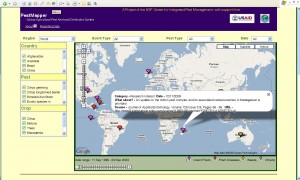- The history of the potato at Shimla.
- Lots of Mediterranean mammals in trouble, including wild relatives of domesticated species.
- SciDev rounds up the science on climate change and diseases. Human diseases, that is, but much also applies to those of crops and livestock.
Andy talks about models
Listen to our friend, colleague and occasional contributor Andy Jarvis talk about his quest to document the predicted effect of climate change on the world’s top 50 crops. Via.
Goats gnaw on geographic given
![]() We’re used to thinking — or at least assuming — in agrobiodiversity conservation that genetic distance is a monotonically increasing function of geographic distance. It is, after all, a reflection of the great Waldo Tobler’s First Law of Geography: “Everything is related to everything else, but near things are more related than distant things.” And yet. Why should that necessarily be so for crops and livestock, so willfully and incessantly moved to and fro by people in all kinds of unpredictable ways?
We’re used to thinking — or at least assuming — in agrobiodiversity conservation that genetic distance is a monotonically increasing function of geographic distance. It is, after all, a reflection of the great Waldo Tobler’s First Law of Geography: “Everything is related to everything else, but near things are more related than distant things.” And yet. Why should that necessarily be so for crops and livestock, so willfully and incessantly moved to and fro by people in all kinds of unpredictable ways?
A paper just out in Molecular Ecology in effect tests the First Law of Geography with goat genetic diversity data, microsatellites in fact. 1. Goat populations were sampled in 3-8 villages in each of 2-5 communes in each of 10 districts in the remote, mountainous, ethnically mixed Vietnamese province of Hang Giang, for a total of 492 animals. The genetic relationships among the animals were then analyzed.
To the surprise of the authors, the spatial structure of the overall population was poorly explained by simple geographic distance. The ethnicity of their keepers and the husbandry practices to which they were subjected did a much better job of predicting the genetic distance between goats. The most dissimilar goats were not necessarily the ones which lived furthest apart, but rather the ones which were kept in different ways by people of different ethnic groups.
So, if you wanted to maximise the diversity in a Vietnamese goat conservation programme, or your chances of hybrid vigour, you’d pick animals from different ethnic groups or production systems, and not necessarily from different ends of the country. Which is something that I remember sort of almost subconsciously doing when I was collecting crops, but it is nice to see it validated like this. I can’t remember offhand similar work on crops, but no doubt Jacob will set me straight soon enough. In the meantime, I revel in a rule proven.
Reporting threats to agrobiodiversity: A modest proposal
Yesterday Hannes, à propos of something else, reminded me of a post I did a few months back about ProMED which asked the question “Why do we still not have an early warning system for genetic erosion?” Today I read about pestMapper — “[an] internet-based software tool for reporting and mapping biological invasions and other geographical and temporal events.” Whose objectives is basically to make a more participatory, Web 2.0-like ProMED. Coincidence? Maybe. Anyway, this is exactly the kind of thing we’ve been thinking here a “global genetic erosion threat reporting and monitoring portal” might look like. Any thoughts? An idea worth pursuing?

Nibbles: Chicory symbolism, Watermelon disease, Olive documentation, Camassia quamash, Pig maps
- Chicory averts evil. Gotta get me some.
- Genebank watermelon material reveals sources of resistance to WVD caused by SqVYV. What?
- Israelis, Palestinians and Germans collaborate on DNA fingerprinting and quality evaluation of olive trees. Wait, what? Scroll down.
- Genetic structure of Native American food plant not really affected by Native Americans. This is the bulb that kept Lewis & Clark alive, apparently.
- Tracing Paper compares hog distribution in 1922 and now, finds little difference.